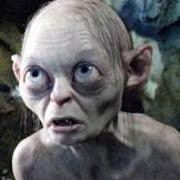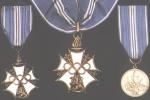-
Posts
141 -
Joined
-
Last visited
Recent Profile Visitors
1,847 profile views
Pete A's Achievements
-

Finland Finnish Olympic Decoration:
Pete A replied to Hauptmann's topic in Northern European & Baltic States
Well, looks like there really isn't much to add. These awards seem to be quite unknown in the local literature too. Following information comes from the Book "Kunniamerkkikirja" by Juha Tetri, as well as the bad picture. Sorry about the quality, apparently I don't know how to scan. Also, I don't own a Rick Research -approved "holy Epson", but some old HP that's only good for scanning text Anyway, this should at least give you the idea. Orders of Merit of Finnish Olympic Games were founded on 21.7.1951, after the German example, as stated above. They were designed by Oskar Pihl, and intented to be rewarded to persons who had contributed in making the 1952 games a success. The regulations of bestowal were strict, and followed the "usual manners and international practice" (whatever that means). Slighty under 3000 orders and medals were bestowed in total, of which some 1/5 to foreigners. However, they did receive nearly half of the 1st class orders. Pete [attachmentid=50942] -

Finland Finnish Olympic Decoration:
Pete A replied to Hauptmann's topic in Northern European & Baltic States
Dan, in my opinion that really is one of the nicest awards around, and by being simply much more elegant, it beats the hell out of it's German counterpart any given day. I don't have any of my reference books at hand right now, but out of memory I can tell you, that these were created for the 1952 Olympics in Helsinki, and indeed after the German example of 1936. The order came in three classes, 1st class neck badge, 2nd class breast badge, and a merit medal. The ribbon is light blue with white stripes, the enamel is white, everything else gold. The reverse side features a stylished "1952". The Medal is silver and features a picture of the order. If I remember correctly, the majority of the 1st class crosses went to the foreign officials of the Olympic Commitee. But I try to post more details and color pictures soon. (unless someone else does that first, of course ) Regards, Pete -

1930s Latvian ? Badge & "In Wear" Photo
Pete A replied to a topic in Northern European & Baltic States
It looks like there is two vertical bars in his rank tab? That would make him a corporal (kapr?lis). No idea about the badge, but it sure is pretty. Pete -
I know nothing about WW1 german straps, but this one just looks too clean to me. Maybe later-made traditions piece? Unit in question is the Royal Prussian J?ger-Batallion Nr. 27. Is the grey(ish?) color correct for j?ger uniforms, which all the sources mention being green? And the number? Does that seem correct? As far as I know, it was ordered to be removed from the straps in the spring of 1917, when the battalion was transfered to Libau for training. The only picture I got, I'll see if I can get more. Thanks, Pete [attachmentid=49797]
-

Identefication of awards
Pete A replied to Igor Ostapenko's topic in Northern European & Baltic States
Hi Igor, very nice that medal for zeal! The Swedish medal is 1967 Jubilee medal for King Gustaf VI Adolf's 85th birthday (Konung Gustaf VI Adolfs minnesmedalj med anledning av 85-?rsdagen [GVIA:sMM]). Made of silver, diameter 33mm and the ribbon is that of the Seraphim order. Here's a thread on a Swedish forum where you can see a similar miniature: http://samlarforum.skalman.nu/viewtopic.ph...a1c27e81dde6c62 Pete -
Here's the full link: http://cgi.ebay.com/Russian-Order-FABERGE_...1QQcmdZViewItem The seller says nothing about the size, so it might be more of a unofficial jeton than a neck badge? To me this looks like something that an attending cadet might have come up, to show where he's studying. "Be true to your school" - sort of thing? After all, the official badge wasn't received until graduation. But the one thing that really bothers me with this badge, is why on earth would a high quality maker like Faberge put their stamps so crudely on the front of the badge?, instead of the empty reverse where it would be more appropriate? Pete
-
It's always sad to see old military traditions being brought down. That has happened a lot here in Finland lately, and even though our examples aren't as old as the British, it still is quite shameful. I like animals as much as the next guy, and hate to see them being treated cruely and in a useless manner. But is this really an example of such behaviour? Are those hats really so bad? It's hard to see them resulting the extinction of the black bear population. They probably won't go out and kill a bear in extremely cruel manner every time it looks like a new hat is being needed, or do they? Don't these lawmakers have any actual, bigger, and more acute problems to be concerned of? Glad to see this happens outside Finland too! And how come they really can't come up with an effective alternative to that bearskin? Come on, it's the 21st century. Hell, the man has walked on the moon but still we can't manufacture fake-fur that has the characteristics of bearskin? When I did my military service in 1998, I was issued a 1939 dated mess-kit. And it really looked like it had gone through the war. No to mention the funny taste. But that wasn't necessarily the kit's fault. Pete
-

Finland My First Medals of Finland
Pete A replied to Riley1965's topic in Northern European & Baltic States
The veteran badge is participants insignia for Finnish War Veterans Union's (Suomen Sotaveteraaniliitto) annual meetings of the local chapters. It was meant to be worn on the lapel of the civilian costume during the event. You sometimes see these with clasps denoting the year and/or the location of the meeting(s) the wearer has participated in. There's also a version with red and white ribbon (I don't know why). These seem to have been in use from the 60's to 80's, but I don't recall seeing them anymore recently. Some other examples (picture taken from a local online-auction site): [attachmentid=47142] Pete -

Identefication of awards
Pete A replied to Igor Ostapenko's topic in Northern European & Baltic States
Hi Igor, 1) Swedish, hard to say what, since the observe is similar in many medals. What's the reverse like? 2) Knight's cross of Danish order of Dannebrog 3) British Royal Victorian Order (commander, I guess?) 4) Austria, 1st republic, Order of Merit (these came in red and white enamel, maybe someone else can explain their difference?) 5) Russian medal of zeal, maybe? Pete -

Albania The Decorations of Socialist Albania 2nd Edition
Pete A replied to Nick's topic in Southern European & Balkan States
I really can't say anything that isn't already said in the thread concerning the 1st edition. First class presentation, really. While socialist Albania isn't actually in my sphere of interest, I sure did enjoy reading this wonderful guide. Also, I believe that we have many members here, who can be considered experts (or maybe even leading experts) in their own field of collecting - or research - and it would be great to see Eric's fine example resulting more publications like this. Eric, I hope this "living guide" keeps on living and evolving, and increases not only our knowledge of the subject, but yours as well. Thanks a lot, Pete -

Order of the Rose Brasil
Pete A replied to g_deploige's topic in Rest of the World: Militaria & History
Andreas' site has - once again - huge amount of information regarding this beautiful order: http://medalnet.net/brazil_rose.htm -
The reason behind these black enameled crosses is unknown (a lot of theories though, like the mourning of the death of Czar Nicholas I etc.), but like Daniel said, this eventually became purely a fashion-statement. These crosses are always privately made, unofficial pieces. The trend was in use around 1860-1880, and concerned orders of St. Alexander Nevsky, St. Vladimir, St. Anna and St. Stanislav. Regarding the awards to non-christians, they were the same as those awarded to christians, except that since 1844 the portraits (or the monograms, like in case of St. Stanislav) of saints or cross symbols were replaced with the state emblem, the imperial double-headed eagle. Pete
-
At the moment I work at the local museum, and every once in a while, usually when a new exhibition opens up, the responsible department makes it possible for the staff of other departments to see it in advance. This time it was the opening of the art museum's summer exhibition, which was made up of "most requested" works in their collections. Since our art museum is also Finland's leading "poster museum", that form of art was naturally well represented. There was this one poster, that I found especially interesting. Or not the poster itself, which was just a small 1930's ad for local brewery, but the artist whose work it was. He was a German named Hans Br?ckner, born 1897 in Dresden, died 1949 in Helsinki. The curator knew very little of him, only that he had studied art in his youth, been a "combat pilot" during WW1, and moved to Finland after the war. Here he married a Finnish woman in 1924, and worked as a set decorator in theaters, and later as the art director of Finland's leading printing house. Now, can anybody tell me more about Br?ckner's WW1 service? Awards? Units? What was his connection to Finland? He isn't on my list of German airmen who participated in 1918 civil war. Maybe he was one of those "instructors" who came to build the Finnish army after May 1918? Or maybe an instructor for Finnish pilots who went to Germany for training? Or was he even a pilot at all? Thanks, Pete







